What Are Plyometrics and Why Should You Do Them?
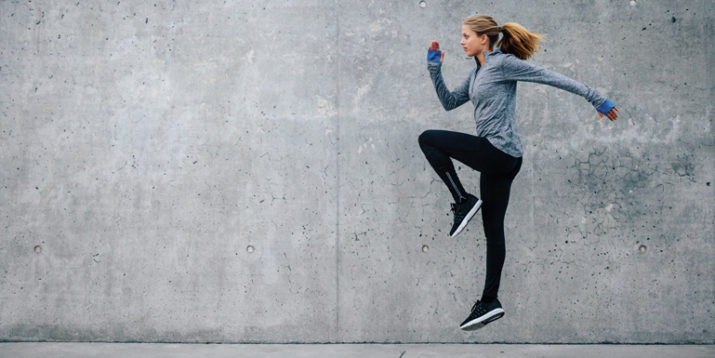
If you’re on a quest to become a faster, more agile athlete, you’ve likely heard the term “plyometrics.” Whether you’re aiming to jump higher, run a quicker 40-yard dash, or sprint sideline to sideline in less time, it pays to become acquainted with this type of explosive training.
But even if you’re not focused on athletic pursuits, plyometrics should still have a place in your training program. Here’s what plyometrics are and how they can benefit you.
What Are Plyometrics?

Previously referred to as “jump training,” plyometrics is a type of exercise that focuses on combining strength with speed in order to enhance power output.
A key component of many sports, such as basketball, soccer, and tennis, plyometric training can enhance athleticism, strengthen the most powerful muscles in your body, and much more.
Here’s a breakdown of the benefits of plyometric exercises, and how to safely add them to your workout routine.
The Benefits of Plyometrics
In order to propel your body off the ground and land safely, a lot has to happen in your muscles, tendons, ligaments, and joints — specifically, eccentric contraction and concentric contraction (a.k.a. the lengthening and shortening of your muscle fibers).
“Plyometric training targets your type II (a.k.a. fast twitch) muscle fibers, which are the largest, strongest, and most powerful in your body,” explains Trevor Thieme, C.S.C.S.
“It doesn’t matter whether you are a seasoned lifter or a strength-training newbie — studies show that plyometrics can help you build muscle as effectively as conventional weightlifting and that combining the two can help you reach your goals faster than focusing on either one alone.”
Not only that, the impact your body absorbs from landing has benefits for your bones, spurring them to become denser.
And if you’re an athlete, plyometrics can improve your agility and explosiveness when it comes to fast-response moves, such as sprinting, quickly changing direction on the field or court, and, of course, jumping (say, to rebound in basketball).
How to Get Started With Plyometrics
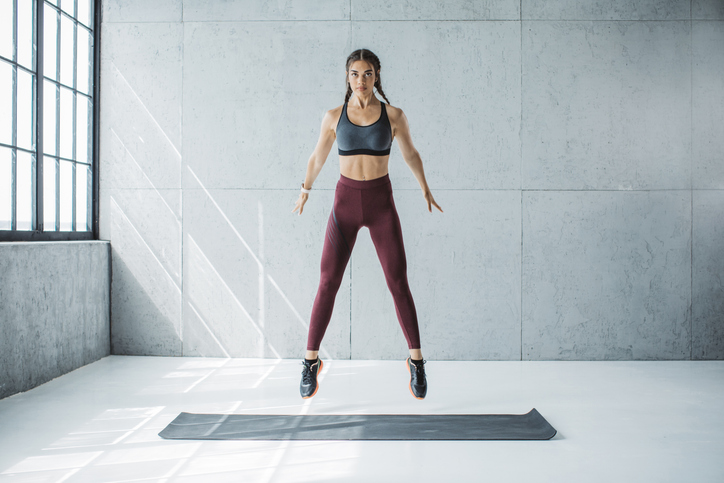
If you’re new to plyometrics, as with anything else, you should start small. This is especially important for plyometric exercises because correct form is so crucial, as you need to both lift your body off the ground and control the landing.
This dual-action makes plyo exercises more difficult and complex than most other exercises. If you have a movement dysfunction, it will be magnified when the speed and power of a jump are applied to it.
Thieme suggests incorporating plyometric training into your workout plan by adding a plyo element to exercises with which you’re already familiar.
“So you might do the jump squat instead of a conventional squat, or the split jump to complement a conventional lunge,” he says.
When learning a new plyometric move, you can first perform it without the jump to get a handle on the form, strength, and stability required to do it correctly. Once you have all of that, you can then add the jumping movement.
Another way to start small is to choose lower-impact plyo exercises, such as jumping jacks, jumping rope, skaters (hopping side to side from one foot to the other), and even some martial arts or boxing activities that involve punching and kicking.
And don’t ignore the upper body: Plyo push-ups (where you “jump” your hands up on the press, either off the floor, an inclined surface, or even the wall) and medicine ball throws are great for building explosive power above the waist.
Just always be aware of your form. When you become tired, form tends to suffer, and the risk of injury increases.
Is there anyone who shouldn’t do plyometric exercises?
The short answer is no, as long as your doctor hasn’t identified a reason why you shouldn’t (such as deteriorating joints or bad knees).
However, “if you’re significantly overweight, add plyometric exercises to your training plan gradually, and stay away from high-impact moves like box jumps entirely,” says Thieme.
“Doing too much, too soon — or doing advanced exercises before you’re ready for them — can stress your joints, increasing your risk of injury.”
10 Plyometric Exercises to Boost Your Power
Although many people think of plyometric exercises as a lower-body workout, they can target your upper body as well.
Here’s a representative sample of plyometric exercises that effectively work many of the body’s large muscles.
1. Box jumps
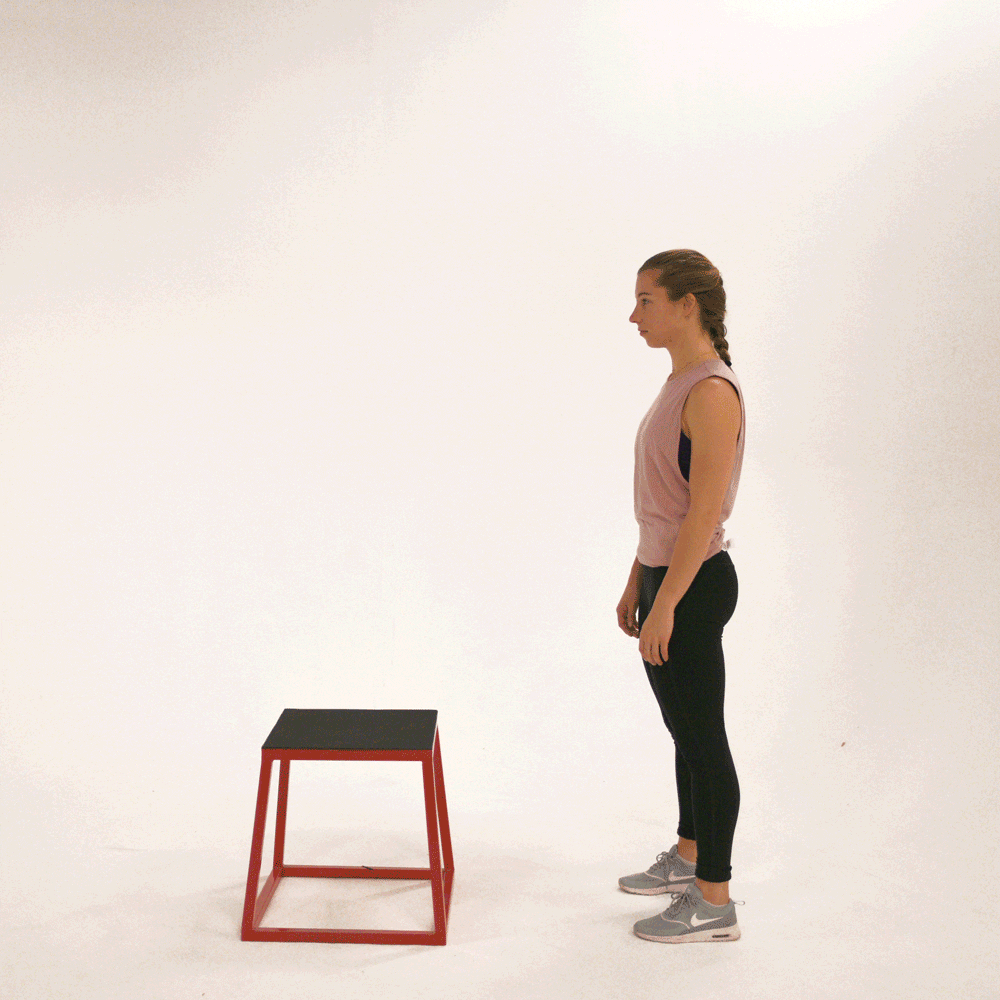
- Stand facing the box (or other stable elevated surface) with your feet hip-width apart, and bend your knees into a quarter squat, bringing both arms behind you.
- Swing your arms forward and jump up and onto the box, landing with your knees bent and both feet on the middle of the box.
- Stand up, and then step down from the box one foot at a time.
2. Skater jumps
- Start with your right leg slightly bent and your left foot tucked behind it.
- Push off your right leg to move your body to the left, landing on your left leg, and tucking your right leg behind it.
- Continue the lateral jumps, landing softly and with bent knees each time.
3. Plyo push-ups
- Assume a plank position with your feet together (or separated slightly), your body straight from head to heels, and your hands in line with (but slightly wider than) your shoulders.
- Squeeze your glutes and brace your core to lock your body into position.
- Keeping your elbows tucked against your ribs, lower your torso until your chest is within a few inches of the floor.
- Pause, and then push up with enough force for your hands to leave the ground.
- Land softly, and transition immediately into your next rep.
4. Tuck jump
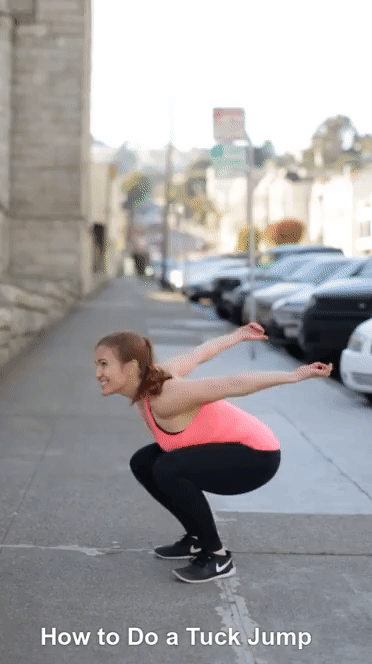
- Stand with your feet hip-width apart and lift your fully extended arms, palms down, to chest height.
- Bend your knees in a quarter squat and, exploding off the balls of your feet, jump straight up in the air.
- As you jump, pull your knees up toward your chest. Try to touch your knees to your palms.
- Land softly with your feet hip-width apart and your knees slightly bent.
5. Split jump
- Stand in a staggered stance with your right foot about two to three feet in front of your left foot. Let your arms hang by your sides.
- Keeping your chest up, back straight, and core engaged, lower yourself into a lunge: front thigh parallel to the floor, rear knee bent to about 90 degrees.
- Jump straight up so that both feet leave the floor. Swing your arms up in front of your chest will help optimize your momentum and power.
- Switch leg positions in the air, landing softly with your left foot forward.
- Immediately lower your body back into a lunge to begin your next rep.
- Continue alternating legs with each rep.
6. Standing chest pass

- Stand at least three feet away from the wall with your feet shoulder-width apart (soften your knees to protect your joints). Hold the a soft wall ball between your hands at chest height.
- Engage your core and press down into the floor with your feet. Explosively throw the wall ball into the wall as hard as possible and catch it on its return.
- Continue to throw the ball back and forth repeatedly for reps.
7. Wall ball side slam

- Stand sideways with your left shoulder a little more than arms-length away from a wall. Place your feet shoulder-width apart. Hold a wall ball with both hands at belly height and extend your arms out in front of you. Soften your elbows.
- Twist your torso away from the wall toward the center of the room. Then, turn your torso quickly back toward the wall to throw the ball against the wall as hard as possible.
- Catch the ball on the rebound and repeat continuously for the assigned rep count. Turn and repeat the drill on the other side.
8. Wide in & out abs
Workout: INSANITY – Max Interval Plyo
- Assume a plank position with your hands in line with (but slightly wider than) your shoulders, and your feet wider than hip distance.
- Squeeze your glutes and brace your core to keep your body in a straight line.
- Keeping your hands on the ground, jump your feet in to come under your hips, keeping the feet shoulder-width apart.
- Then, jump back to the starting position.
9. Scissor kick jumps
Workout: P90X3 – AgilityX
- Stand on your right leg, with your left leg lifted straight out in front of your body.
- Moving to the left, jump to your left leg, lifting your right leg straight out in front of your body.
- Switch once more to your right leg, and then once more to your left leg.
- Then reverse the direction jumping to your right, still alternating legs.
10. Overhead slams
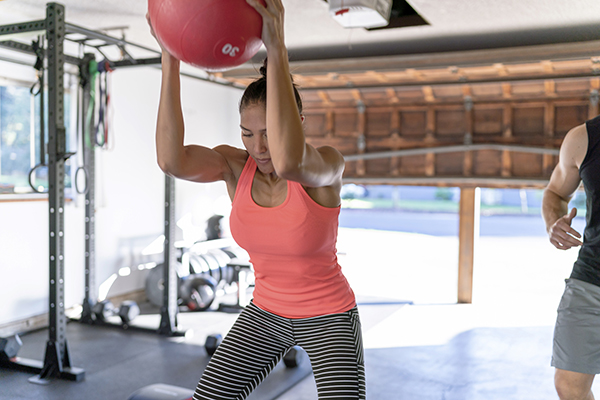
- Stand with feet hip-width apart and a soft bend in the knees, and hold the medicine ball with both hands over your head.
- With explosive force, slam the ball to the ground, engaging your core and glutes while putting more bend in your knees and pushing your hips back slightly. Try to slam the ball hard enough so it bounces back upward.
- Catch the ball and raise it back overhead.
